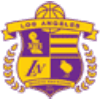Magic Johnson. Kobe Bryant. Hollywood. Malibu. Palm trees. Purple and gold. Exceptionalism. Showtime.
A Los Angeles Lakers-themed word association game could go on forever — such is the vastness of the franchise’s history.
“Lakes!” Lakes?
Even non-California natives shouldn’t be surprised by the fact that lakes don’t necessarily qualify as one of the Golden State’s attractions. Hence, they would make an unlikely muse for a pro basketball franchise searching for the perfect name for its brand.
The Los Angeles Almanac comes up with just 12 names of natural water-filled basins surrounded by the L.A. County’s lands. The now-defunct OC Almanac of the neighboring Orange County lists 18 major lakes located in the area.
Meanwhile, to get to California’s largest lake — Lake Tahoe, nestled in the Sierra Nevada mountain range — one would have to take a 440-mile drive from Crypto.com Arena.
So, why are the Lakers called the Lakers? What is a Laker?
Why are the Los Angeles Lakers called the Lakers?
This might muddle things up even further, but the Lakers weren’t even initially called the Lakers. In fact, the team didn’t even start in Los Angeles.
The franchise started off as the Detroit Gems after Michigan accountant C. King Boring and jeweler Maurice Winston founded the team as part of the National Basketball League (NBL) expansion in 1946.
Michigan is part of the Great Lakes territory. If you’re still asking yourself “What is a Laker?” you may be able to make the connection now.
In what would be considered an ironic turn of events in the future, the newly-established franchise didn’t initially receive much attention, even from local newspapers, according to the old Detroit Times’ night sports editor George Maskin quoted by Roland Lazenby in his book, “The Show: The Inside Story of the Spectacular Los Angeles Lakers in the Words of Those Who Lived It.”
Also, the Gems were spectacularly bad.
One day during the latter stages of their inaugural season, only six people reportedly came to watch the Gems play. Winston is believed to have issued the devoted fans with a refund for the tickets they had purchased.
The Gems ended their debut campaign with a 4-40 record — which would surprisingly turn out to be a blessing in disguise.
When the Gems turned into the Minneapolis Lakers
The Gems technically folded after their first NBL season. However, two Minnesota businessmen, Ben Berger and Maurice Chalfen, came to the franchise’s rescue.
Berger and Chalfen bought the nearly-defunct organization for a staggering $15,000 — an equivalent of today’s $200,000 — even though they could acquire it for free a few months later. And they did so precisely because of how bad the Gems were, Sid Hartman explained in “The Show.” And this was the start of the soon-to-be Minneapolis Lakers.
Hartman, a young, well-connected newspaper carrier-turned-sportswriter, worked for the Minneapolis Star Tribune at the time but also used his sports knowledge to advise local businessmen. One day in 1947, he reached out to Winston on Berger and Chalfen’s behalf, presenting him with the offer for the purchase of the Gems.
They picked Detroit because its terrible record would most likely land them the No. 1 pick in the 1947 draft, said Hartman, who would initially work as the team’s de-facto general manager after the takeover.
But Hartman had his eyes set on a bigger prize. Another NBL franchise, the Chicago American Gears, seemed destined to fall — just like the Gems who, funnily enough, notched one of their four wins against the Gears in 1946-47.
If the Gears did collapse, Hartman envisioned the franchise potentially earning the drafting rights to one of the Chicago team’s stars: George Mikan.
The plan he had hatched convinced Bergen and Chalfen to purchase the Gems. Hartman flew to Detroit with a check for $15,000 signed by the two wealthy men; the transaction would soon get the green light from the NBL.
Not much traveled to Minnesota during the relocation process, as Detroit hardly owned anything besides the jerseys at that point.
Even the jerseys didn’t have much value, Hartman recalled.
Building the Minneapolis Lakers
Minnesota’s new pro basketball team needed to build its new identity. As part of the process, the newly-anointed general manager — Max Winter — sought to find a new name for the franchise soon after he joined it.
Lazenby wrote the name came to be chosen through a “newspaper contest.” A local paper claimed it was a “citywide radio contest.” One way or another, the franchise would eventually settle on “the Minneapolis Lakers” — even though Winter reportedly fancied a different moniker: the Vikings.
His choice probably makes it clear the Lakers wouldn’t be the man’s last venture as a sports entrepreneur.
Various dictionaries define “a laker” as someone — or something — associated with a lake: be it a person, a ship, or a fish. That partly justifies the rationale behind the name pick. The Lakers weren’t a nod to, simply, lakes but the lakes.
It honored Minnesota’s legacy as the “Land of 10,000 Lakes.”
The creativity of the Minnesota resident who came up with the name reportedly earned the man a $100 savings bond.
Minnesota found its new name and it also found its new coach: John Kundla, a former University of Minnesota standout. After graduation, Kundla served in the Navy during World War II — still, he reportedly played pickup basketball games on a ship in the Atlantic Ocean.
After his service for the Navy came to an end, he coached at St. Thomas for a season before agreeing to join the Minneapolis Lakers.
One might ask, what happened to Hartman’s plans of poaching Mikan from the Gears?
As the bright writer predicted, the Gears did fall apart and the Lakers received the 6-foot-10 star center’s lottery rights. But Mikan didn’t put a late ‘40s equivalent of a Lakers-themed full cap on and posed to a camera for a commemorative black-and-white photograph, celebrating his selection with the No. 1 pick.
The NBL draft didn’t boast the same significance as the NBA draft does these days.
Why did the Lakers move to L.A.?
The Lakers had to negotiate with Mikan, who leaned toward staying near Chicago, where he grew up. It took some effort from Hartman and Winter to convince him to commit to their project. Part of that effort involved Hartman purposefully making Mikan miss his flight back to Chicago to buy some time for the Lakers when the negotiations seemed to be over — a scheme concocted by Winter.
When Hartman drove the center and his agent to the airport, he took a much longer route. He went north, to the city of Anoka, instead of south, where he should have gone. Mikan missed his flight, which was the last one that flew to Chicago that day. Just as planned, the center had to stay in the area for another night.
Within the next 24 hours, he would sign a three-year deal with the Lakers.
Mikan teamed up with future Hall of Fame forward Jim Pollard in the Lakers’ frontcourt to carry Minnesota to a championship in the franchise’s debut season. They reached the playoffs with an NBL-best 43-17 record and then beat the Rochester Royals 3-1 in the finals.
The Lakers would triumph again the following season, having left the NBL to join the rivaling Basketball Association of America (BAA)… and then again, in 1949-50, claiming the first-ever NBA title after the NBL-BAA merger led to the league’s creation.
Minnesota became basketball’s first true dynasty, as Mikan and Co. would follow their three title victories in three different leagues with a three-peat between 1952-1954.
The Lakers’ dominance had a profound impact on the game, inspiring rules that are used in modern-day basketball. Teams went as far as to stall after taking the lead in a game against the Lakers and Mikan, their mighty center — leading to the eventual introduction of the 24-second shot clock.
Meanwhile, Mikan’s extraordinary ability to swat shots away from under the basket would prompt pro basketball leagues to adopt the goaltending rule, already present in the NCAA.
So considering the near-instant rise of the Minnesota team, why did the Lakers move to L.A.?
Following Mikan’s retirement, the interest in Lakers basketball began to wane — partly because the team’s results worsened significantly without the main man running the show.
Hartman would later say that Minnesota fans “were spoiled by all the winning” that occurred in the Mikan era.
The idea of relocating the franchise further accelerated in the late ‘50s, particularly after the plane’s team crash-landed into a snow-covered cornfield in January 1960. The Lakers were making their way back from St. Louis after a 135-119 loss to the Hawks, which back then resided in Missouri.
Also, rumors of Harlem Globetrotters creator Abe Saperstein’s plans to found a basketball franchise in California is believed to have contributed to the Lakers’ West Coast move — as did the success of the Brooklyn Dodgers after they left New York for L.A.
Bob Short and Frank Ryan, who had bought the money-hemorrhaging Minnesota franchise in 1957, pulled the trigger at the start of the next decade. Their team entered the 1960-61 NBA season as the Los Angeles Lakers.
Creating a New Home in L.A.
Short didn’t deem renaming the already-established franchise necessary — even if it would make L.A.’s nickname geographically-confusing. But his decision didn’t set a precedent.
The Dodgers hadn’t adopted a new name after their move either, even though baseball fans in Los Angeles likely didn’t have to navigate past electric trolley tracks on the way to games as those in Brooklyn used to — which is why they had become the Dodgers.
Among most recent examples, the bear population in Memphis can’t compare to the one that inhabits British Columbia, Vancouver’s home.
And Utah has certainly become (in)famous for many reasons, but ushering in the golden age of Jazz music isn’t one of them.
What did change under Short’s time at the helm of the Lakers were the jerseys — but only slightly.
The franchise retained the blue and white color scheme but dropped the gold trim that adorned the Lakers’ uniforms before the relocation. And, powder blue of the Mikan era was eventually replaced with royal blue as the dominant coloring, which is now widely associated with Elgin Baylor’s times.
However, L.A. would adopt the purple and reintroduce the gold under Jack Kent Cookie’s ownership later that decade.
The Lakers started a new chapter in their history, but they did so without one of their founding fathers, as Hartman left around the time of the Bob Short takeover. He would still root for the team he had built from scratch, while covering the Minnesota Vikings and then the Minnesota Timberwolves — on the way to becoming the legend of Minnesota sports.
Hartman got to see the Lakers win all of the 12 NBA championships they have so far won in the L.A era. He passed away on Oct. 18, 2020, a week after LeBron James and Anthony Davis led the Lakers to victory in the Orlando bubble, at the age of 100.
The iconic L.A. Lakers
The provenance of the Lakers’ name might still be confusing to some, something difficult to associate the brand’s razzle-dazzle with to others. Hence, let it be known the Purple and Gold’s success story cannot be told without mentioning the great, blue Minnesotan lakes, which became a part of the organization’s identity while it was fighting for survival and then watched it grow into basketball’s first dynasty.
The name serves as a reminder that before the Lakers could settle in the sunny, palm tree-rich Los Angeles lands and bask in the glam and glory of their own success, they first had to grit their teeth in misery, failure, and the numbing mid-eastern cold — in the city of Minneapolis, where it rose from the ashes of the crushed Detroit Gems.






